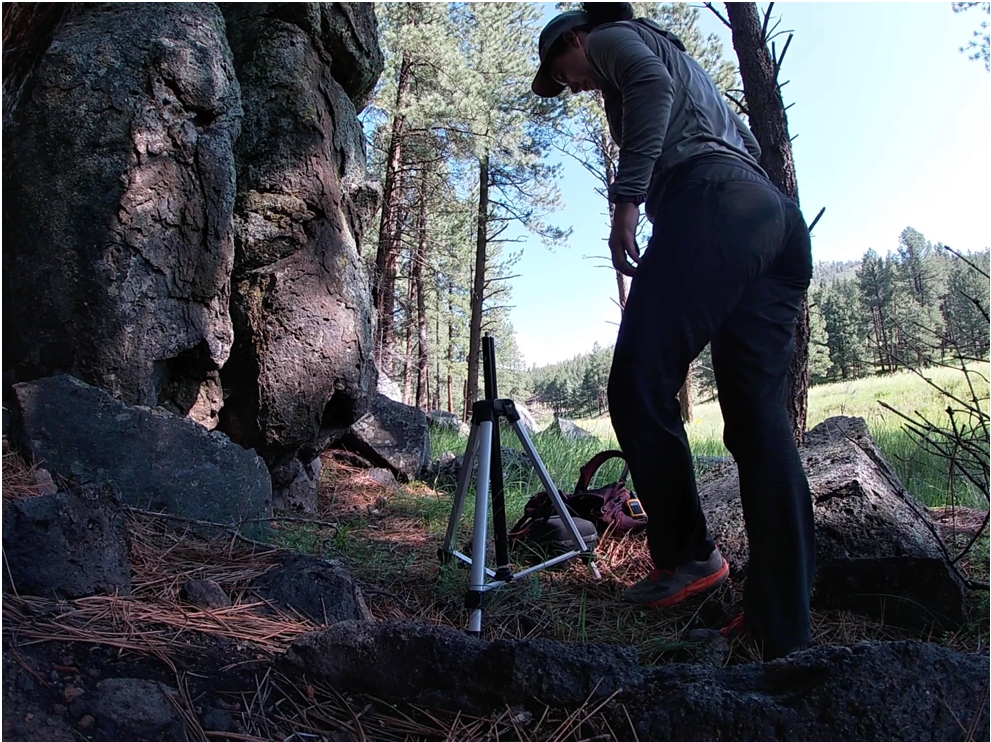Origin of explosion pits on Banco Bonito Rhyolite flow
An invited blog post by Ph.D. Candidate Jessie Bersson (pictured at end of post) of ASU's School of Earth and Space Exploration.
New Mexico’s Valles Caldera is one of the best studied examples of a resurgent caldera, but the emplacement of its youngest deposit remains something of a mystery. The Banco Bonito Rhyolite Lava Flow, estimated to be ~68 thousand years old1, is dotted with dozens of previously unstudied secondary explosion pits. Lidar topography published in the past decade has provided a novel look at the surface of the Banco Bonito, otherwise obscured by a pine forest, and an opportunity to investigate the mechanism that drove these explosive features.
I am a PhD candidate at Arizona State University investigating these explosive features to advance our conceptual model of rhyolite flow dynamics and their associated volcanic hazards.

DRIVING RESEARCH QUESTIONS
Secondary explosions pits are thought to be the scars of steam driven explosions, but the particulars of the mechanism that formed the Banco Bonito explosion pits are unknown. My research is driven by the following questions:
1. What is the source of the steam? The steam is either magmatic or meteoric in origin.
2. Where within the lava flow did the steam accumulate and pressurize prior to exploding? The steam must have accumulated beneath an impermeable cap to build pressure and drive the explosion, but the specific location of this accumulation remains unknown. Possible location included within a porous horizon of the texturally stratified lava flow, within a void created beneath a pressure ridge, or in the boundary between two overlapping pulses of the lava flow.
3. When did the explosions occur? The age of the explosions relative to the flow emplacement is not defined. Did the explosions occur while the flow was still advancing or was the flow already emplaced?

APPROACH
To answer these driving questions, I have spent the past year mapping the explosion pits on the surface of the Banco Bonito Flow.
1. To address the origin of the steam, I am calculating the volume ejected from each explosion pit to estimate the amount of steam needed to drive the explosions. Using this estimation, we can determine if it would be feasible to exsolve the amount of steam needed from the magma.
2. To address the location of steam accumulation, I am creating detailed ejecta maps of five representative explosion pits. These maps detail the textures (ranging from frothy pumice to glassy obsidian) and sizes of clasts ejected from within the rhyolite flow. This information tells us about the depth of steam accumulation and the textural complexity of the lava flow where these explosions occur. I use an EMLID multi-band RTK (real-time kinematic positioning) GNSS (Global Navigation Satellite System) to map the ejected clasts with centimeter precision.
3. To address the age of the explosions relative to flow emplacement, I am analyzing the shape of each explosion pit. If the pits were formed after the flow stopped moving, they should be circular. If the pits were formed while the flow was moving, they should be oblong.
IMPLICATIONS
Investigating these explosive features provides insight into the emplacement of the Valles Caldera’s youngest deposit, but it also illuminates a hazardous lava flow process we know little about. While secondary explosion pits are not uncommon in basalt flows or pyroclastic deposits (with the steam from those explosions thought to originate from saturated substrates or the incorporation of ice), they have rarely been documented in rhyolite flows. In fact, we know relatively little about rhyolite lava flows in general. Only two rhyolite lava flows have been observed in recent history, both of which occurred in the Chilean Andes. My work aims to contribute to our growing conceptual model of rhyolite flow dynamics.

ACKNOWLEDGEMENTS
This research is part of Jessie Bersson’s PhD work with Prof. Amanda Clarke and Prof. Ramon Arrowsmith at Arizona State University. This work has been supported by Arizona State University School of Earth and Space Exploration, the UGSG Kleinman Award for Volcano Research, and the Colorado Scientific Society. Substantive scientific discussions with Jon Fink, Alexa Van Eaton, Mike Poland, and Curtis Manley were important to the evolution of the work.
REFERENCES
1Zimmerer, M. J., Lafferty, J. & Coble, M. A. The eruptive and magmatic history of the youngest pulse of volcanism at the Valles caldera: Implications for successfully dating late Quaternary eruptions. J. Volcano. Geotherm. Res. 310, 50–57 (2016).
2OpenTopography. Jemez River Basin Snow-off LiDAR Survey. (2012) doi:10.5069/G9RB72JV.






